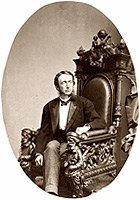Symbols of the University | The Cornell Public Library | Cornell’s Twelve Presidents | | Andrew Dickson White, President, 1866-1885 | | Charles Kendall Adams, President, 1885-1892 | | Jacob Gould Schurman, President, 1892-1920 | | Livingston Farrand, President, 1921-1937 | | Edmund Ezra Day, President, 1937-1949 | | Deane Waldo Malott, President, 1951-1963 | | James Alfred Perkins, President, 1963-1969 | | Dale Raymond Corson, President, 1969-1977 | | Frank Howard Trevor Rhodes, President, 1977-1995 | | Hunter Ripley Rawlings III, President, 1995-2003 | | Jeffrey Sean Lehman, 2003-2005 | | David J. Skorton, 2006 | Inaugurating the Presidents |
| 
Cornell’s Twelve Presidents 
On April 27, 1865, Governor Reuben E. Fenton, in his chambers in the old State Capitol in Albany, signed the bill that constitutes the charter of Cornell University. When Cornell was founded in 1865, it was the culmination of the dreams of its founders, Ezra Cornell and Andrew Dickson White. The Morrill Land Grant Act had provided a mandate and support for the teaching of agriculture and the mechanic arts. Cornell and White considered it essential that these studies be integrated with a broad liberal education. On February 7, 1865, White introduced into the New York State Senate a bill to establish Cornell University as an institution for “the cultivation of the arts and sciences and of literature, and the instruction in agriculture, the mechanic arts and military tactics, and in all knowledge.”
White was named a member of the Board of Trustees and appointed to draft bylaws. His Report of the Committee on Organization was presented to the Board on October 21, 1866. The report provides a detailed description of White’s conceptions, intellectual and physical, of the new university. The Trustees applauded the Plan and unanimously elected Andrew D. White as the first president of the University. White’s inaugural address described his fundamental ideas: the union of liberal and practical education; equality in prestige between the courses of study; variety of courses and freedom of choice among them; the magnification of scientific study; the need for full cultural development of the individual; student self-government; continued renewal of the Board of Trustees and election of alumni trustees; a close relationship between the University and the state school system, with state revenues provided for higher education; nonsectarianism; and the refusal to make any distinctions by race or sex. All of Cornell’s presidents have developed and expanded White’s basic themes. << Prev | Next >>
| |
